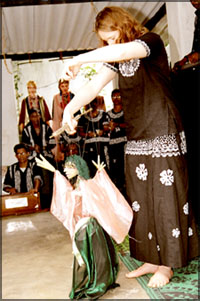|
observer |
|
|
|
|
|
OTHER LINKS |

|

|

|
Alice breaths life into old traditionsGERMAN PUPPETRY: She has the ability to create a theatre of the imagination before your eyes by giving movements and voice to a silent, lifeless figure. She has the touch of expertise to make the characters dance in rhythm to any tune or create a story with gestures to any form of dialogue. She is here to share her experiences of Germanic puppetry with Sri Lanka. "I use all kinds of puppets and words to tell the story which I want
to tell. It is a very visual art. The language She was invited to Sri Lanka by the Goethe Institute to take part in the annual artlink project which the institute together with the British Council, Alliance Francaise and the Vibhavi Academy of Fine Arts has organized. She participated in several workshops which were held at the Puppet Art Center, Piliyandala, and presented a puppet show recently, together with two European and fifteen Sri Lankan artistes. Born in Stuttgart, Germany, Alice had shown interest towards puppetry art at a young age. She had been sixteen years old when she had built her first marionette- an oriental clown carved out of wood. "Marionettes are my most famous instrument. I use all kinds of puppets in my shows. The puppetry in Germany and Europe are different from the Sri Lankan context. For one thing we have an open stage," she explained. Alice's father, Dr. Reinhard Bohm, is a professor at the "Universitat Hohenheim", Stuttgart. She has two sisters, one a doctor and the other a student of the Chinese language. Before her studies, Alice was a technician for plastic and rubber at the company named Teufel Prototypen GmbH. It was through this profession that she gained the experience of handling many different materials and building techniques. Alice had built her puppets using a variety of materials from scarfs to plaster and wood. She had also experimented with various techniques to improve her skill as a puppet builder.
These forms are among many that she had included in her work shops to teach students how to create simple but captivating pieces of art in order to perform with an effective repertoire of movements. Building and performing a scarf puppet, the basics of mariotte performing, carving puppets out of Styrofoam, building theatrical masks, the basics of mask performing and acting are all included as part of her workshops. It was around the year 1997 that Alice came to contact with Albrecht Roser, her teacher at the "International Institute for marionettes, building and performing". Together the duo had taken part in the "International Summer Academy 1997" in Stuttgart and later they had communicated steadily through lessons. It was through his influence that Alice was able to master the form of building marionettes. During her studies, Alice performed as a puppeteer in the productions "Das Stuttgarter Hutzelmannlein und die Historie der schonen Lau" and "Alice in Wonderland" at the State theatre of her hometown. Alice began her studies at the acting school "Ernst-Busch", Berlin, when she went to study puppetry at the University of Music and Performing Arts in Stuttgart. In 2003, she was employed as a teacher for the International Summer Academy at the Puppet Arts Program in Connecticut. The artiste performed her solo show "Episoden" at the Best of ShowstArt festival at the Fridrichsbau-Variete Stuttugart, as well as many other private and public festivals. Another one of her solo shows, "3-Heiroglyphen-1 solo fur 2" had taken her on tours across Europe to countries like Poland, Austria, and Luxemburg. "The puppetry art in European countries are very close in certain ways. Some say that the performances differ orally while others say that the difference is visual. It all comes down to what you feel and what works for you," Alice said. "I love the original rhythm in Sri Lankan puppetry. The ancient traditional links are still evident to feel in this art of story telling. When you compare the Sri Lankan context with German puppetry, there are similarities in the development. However our art developed in a different direction. I like the originality and the way the performance blends with the music and songs in Sri Lankan puppet shows. The Lankan artistes are immensely talented at matching the movements of the puppets with the music and vice versa. It is a very pleasing aspect," she stated. "I have read a book on traditional rookada 400 years before in Sri Lanka. There were pictures of puppets in beautiful traditional costumes. I believe that these are no longer available to some puppeteers due to expenses. I would like to support them to get back to the richness of these costumes." Alice is employed in teaching marionettes at the "University of Music and Dramatic Arts" in Stuttgart. She said that she has a thirst for wanderlust. "I would like to thank my hosts for making this journey possible. I would like to visit the country again if Sri Lanka invites me," she laughed. |
 I use is the movement of
the body of my puppets," stated Alice Therese Bohm, actress, mask
performer and puppeteer from Germany.
I use is the movement of
the body of my puppets," stated Alice Therese Bohm, actress, mask
performer and puppeteer from Germany. 









